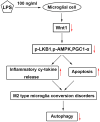Wnt family member 1 (Wnt1) overexpression-induced M2 polarization of microglia alleviates inflammation-sensitized neonatal brain injuries
- PMID: 35603707
- PMCID: PMC9275958
- DOI: 10.1080/21655979.2022.2074767
Wnt family member 1 (Wnt1) overexpression-induced M2 polarization of microglia alleviates inflammation-sensitized neonatal brain injuries
Abstract
Intrauterine infection induces inflammation-mediated microglial activation and brain injury. This study aimed to explore the regulatory mechanism of Wnt family member 1 (Wnt1) in intrauterine infection-mediated microglial polarization. The cell counting kit-8 (CCK-8) assay was used to determine the viability of microglia, and cytokine expression levels were determined using enzyme linked immunosorbent assay (ELISA) kits and real-time quantitative PCR (RT-qPCR). The number of CD206+ and CD16/32+ cells was determined by flow cytometry. Wnt1 expression was analyzed using western blotting and immunofluorescence. Moreover, an in vivo assay was performed to verify the role of WNT1 in inflammation-sensitized brain injury in newborn mice. Lipopolysaccharide (LPS) exposure resulted in a decrease in microglial cell viability while increasing the expression levels of inflammatory cytokines (TNF-α, IL-6, and IL-1β), simultaneously promoting M1-type microglial conversion. However, these effects were rescued by overexpression of Wnt1, which was expressed less in microglia exposed to LPS in vitro and in vivo. Here, we found that Wnt1 activated the LKB1-AMPK pathway, and the inhibition of LKB1 attenuated the rescue effects of Wnt1. In addition, LPS exposure reduced the autophagy of microglia, and Wnt1 overexpression enhanced the autophagy, but this effect was reversed by treatment with an LKB1 inhibitor. Wnt1 activated LKB1 to suppress inflammation-mediated activation of microglia, promote M2-type microglia conversion via the AMPK pathway, and alleviate inflammation-sensitized neonatal brain injuries. This provides a potential avenue for the treatment of neonatal brain injuries.
Keywords: AMPK; LKB1; Microglia polarization; autophagy; wnt1.
Conflict of interest statement
No potential conflict of interest was reported by the author(s).
Figures








Similar articles
-
Wnt1 oversees microglial activation by the Wnt/LRP5/6 receptor signaling pathway during lipopolysaccharide-mediated toxicity.Mol Biol Rep. 2025 Mar 1;52(1):273. doi: 10.1007/s11033-025-10360-2. Mol Biol Rep. 2025. PMID: 40025242 Free PMC article.
-
Curcumin Prevents Neuroinflammation by Inducing Microglia to Transform into the M2-phenotype via CaMKKβ-dependent Activation of the AMP-Activated Protein Kinase Signal Pathway.Curr Alzheimer Res. 2020;17(8):735-752. doi: 10.2174/1567205017666201111120919. Curr Alzheimer Res. 2020. PMID: 33176649
-
Antagonizing peroxisome proliferator-activated receptor γ facilitates M1-to-M2 shift of microglia by enhancing autophagy via the LKB1-AMPK signaling pathway.Aging Cell. 2018 Aug;17(4):e12774. doi: 10.1111/acel.12774. Epub 2018 May 8. Aging Cell. 2018. PMID: 29740932 Free PMC article.
-
Oxymatrine inhibits neuroinflammation byRegulating M1/M2 polarization in N9 microglia through the TLR4/NF-κB pathway.Int Immunopharmacol. 2021 Nov;100:108139. doi: 10.1016/j.intimp.2021.108139. Epub 2021 Sep 10. Int Immunopharmacol. 2021. PMID: 34517275
-
Hydrogen-rich saline promotes microglia M2 polarization and complement-mediated synapse loss to restore behavioral deficits following hypoxia-ischemic in neonatal mice via AMPK activation.J Neuroinflammation. 2019 May 18;16(1):104. doi: 10.1186/s12974-019-1488-2. J Neuroinflammation. 2019. PMID: 31103039 Free PMC article. Review.
Cited by
-
The Metabolic Basis for Nervous System Dysfunction in Alzheimer's Disease, Parkinson's Disease, and Huntington's Disease.Curr Neurovasc Res. 2023;20(3):314-333. doi: 10.2174/1567202620666230721122957. Curr Neurovasc Res. 2023. PMID: 37488757 Free PMC article.
-
Cornerstone Cellular Pathways for Metabolic Disorders and Diabetes Mellitus: Non-Coding RNAs, Wnt Signaling, and AMPK.Cells. 2023 Nov 9;12(22):2595. doi: 10.3390/cells12222595. Cells. 2023. PMID: 37998330 Free PMC article. Review.
-
The impact of aging and oxidative stress in metabolic and nervous system disorders: programmed cell death and molecular signal transduction crosstalk.Front Immunol. 2023 Nov 8;14:1273570. doi: 10.3389/fimmu.2023.1273570. eCollection 2023. Front Immunol. 2023. PMID: 38022638 Free PMC article. Review.
-
Wnt1 oversees microglial activation by the Wnt/LRP5/6 receptor signaling pathway during lipopolysaccharide-mediated toxicity.Mol Biol Rep. 2025 Mar 1;52(1):273. doi: 10.1007/s11033-025-10360-2. Mol Biol Rep. 2025. PMID: 40025242 Free PMC article.
-
Cellular Metabolism: A Fundamental Component of Degeneration in the Nervous System.Biomolecules. 2023 May 11;13(5):816. doi: 10.3390/biom13050816. Biomolecules. 2023. PMID: 37238686 Free PMC article. Review.
References
-
- Fu CH, Zhang BH, Fang CZ, et al. Long non-coding RNA CRNDE deteriorates intrauterine infection-induced neonatal brain injury. Mol Cell Probes. 2020;52:101565. - PubMed
-
- Yuan TM, Sun Y, Zhan CY, et al. Intrauterine infection/inflammation and perinatal brain damage: role of glial cells and Toll-like receptor signaling. J Neuroimmunol. 2010;229(1–2):16–25. - PubMed
MeSH terms
Substances
LinkOut - more resources
Full Text Sources
Other Literature Sources
